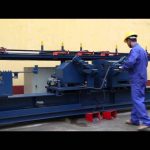When introducing a suspended platform to potential buyers, it's important to highlight its key features, benefits, and potential applications. Here’s a structured way to present a suspended platform to a purchaser:
1. **Introduction to the Product**:
- Start by explaining what a suspended platform is: "A suspended platform, also known as a swing stage or suspended scaffold, is an adjustable, temporary platform used for working at heights. It is typically suspended from an overhead structure using ropes, cables, or chains and can be raised or lowered to the desired working level."
2. **Key Features**:
- **Adjustability**: Explain how the platform can be easily adjusted to various heights, making it versatile for different tasks.
- **Mobility**: Highlight the ease of moving the platform horizontally along the building facade, allowing comprehensive access to large surfaces.
- **Load Capacity**: Discuss the weight capacity of the platform, which can accommodate multiple workers along with their tools and materials.
- **Safety Features**: Emphasize safety components such as guardrails, non-slip surfaces, and stability controls. Mention compliance with safety standards.
3. **Benefits**:
- **Cost-Effectiveness**: Compared to traditional scaffolding, suspended platforms are more cost-efficient for many high-rise tasks due to quicker setup and teardown times.
- **Accessibility**: Stress how the platform provides access to hard-to-reach areas, enhancing the ability to perform tasks such as window cleaning, exterior painting, and maintenance efficiently.
- **Efficiency**: Point out that the platform reduces project time and labor costs by providing a direct approach to work areas.
- **Minimal Impact**: Note the minimal physical impact on the building's facade, an important consideration for historic or delicate structures.
4. **Applications**:
- Provide examples of typical applications including building maintenance, window installation, painting, facade repairs, and construction projects. This helps the buyer visualize the platform’s utility in various scenarios.
5. **Customization and Support**:
- Mention any available customization options that can be tailored to specific needs, such as platform size or the inclusion of additional safety features.
- Outline the support services provided, such as installation assistance, training for operators, and maintenance services.
6. **Closing**:
- Encourage questions and offer to provide a demonstration or a site visit to see the platform in operation. Provide contact information and assure potential buyers of ongoing support and availability of parts.
By structuring the introduction in this way, you effectively communicate the value and versatility of the suspended platform, making it a compelling option for potential buyers looking to enhance their operational efficiency and safety standards.
The Delhi Metro project gave Delhi a world-class mass rapid transit system. More importantly, it stood out from most other public sector projects in India in that it was completed on schedule and within the budgeted cost.
The case describes the organization and planning of the project and highlights the steps taken by the DMRC to ensure the successful completion of the project. It also explains how the DMRC managed the various stakeholders like the central and state governments, the contractors, and the citizens of Delhi, to ensure that the project was implemented smoothly. The case ends with a brief discussion on the future plans of the DMRC































